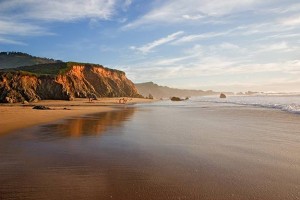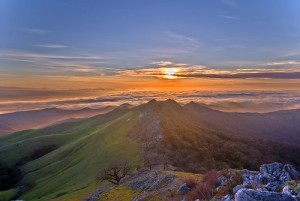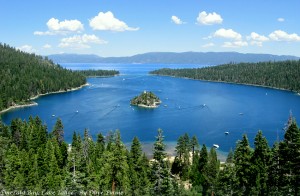Garrapata State Park
Garrapata State Park is one of several state parks located on California’s Pacific coast. It is located in Monterey County on Highway 1, just 10 miles south of Carmel and approximately 18 miles north of Big Sur. Garrapata boasts  two miles of beautiful coastline and breathtaking views of the Santa Lucia Mountains, the base of which can be found within the park’s boundaries. The park does not have an information center, and visitors therefore could find themselves driving through the park along Highway 1 without ever realizing that they are in the park. The only indication of the park’s boundary is a small, inconspicuous sign. Trails and parking areas are marked by numbered access points along the highway. Nevertheless, there are several activities available at the park.
two miles of beautiful coastline and breathtaking views of the Santa Lucia Mountains, the base of which can be found within the park’s boundaries. The park does not have an information center, and visitors therefore could find themselves driving through the park along Highway 1 without ever realizing that they are in the park. The only indication of the park’s boundary is a small, inconspicuous sign. Trails and parking areas are marked by numbered access points along the highway. Nevertheless, there are several activities available at the park.
The main attractions at Garrapata State Park are the park’s hiking trails and its beach. There are five hiking trails in the park, the most popular ones being the Rocky Ridge Trail and the Soberanes Canyon Trail. These two trails meet and form a 4.5-mile loop through the park. Rocky Ridge Trail is probably best suited for more experienced hikers rather than novices due to its extremely steep ascent and descent along the trail. Hikers will experience elevation changes greater than 1000 feet while ascending to Rocky Ridge but will also be rewarded with spectacular views of the mountains and the coastline.
Fremont Peak State Park
The sole reason why travelers should take out time to drive down to the Fremont Peak State Park is the magnificent panoramic view obtained from this place. Lovely hiking trails of the park fall on the grasslands of the highest  peaks of Gavilan Range from where you get to see the unrestrained landscape of the Monterey Bay. The other sceneries to look at from the park include long-stretched Salinas Valley, San Benito Valley and also the eastern section of the Santa Lucia Mountain ranges. The park features dense uninhibited forests of Oak and Pine trees that house several species of mammals and birds. Visitors are allowed to enjoy adventure-staying in the forest in terms of camping or picnicking.
peaks of Gavilan Range from where you get to see the unrestrained landscape of the Monterey Bay. The other sceneries to look at from the park include long-stretched Salinas Valley, San Benito Valley and also the eastern section of the Santa Lucia Mountain ranges. The park features dense uninhibited forests of Oak and Pine trees that house several species of mammals and birds. Visitors are allowed to enjoy adventure-staying in the forest in terms of camping or picnicking.
There is an Astronomical Observatory in the Fremont Peak State Park wherein a 30 inch reflecting telescope is available for public viewing programs on scheduled evenings. Generally astronomy based educative and entertaining programs are organized on the evenings of fall, summer and spring which starts from April and continues till October. On the moonless Saturdays, most of these programs are held at around 8 p.m. You are supposed to arrive to the observatory before sunset; otherwise the vehicle lights might hamper the vision of the astronomers. The astronomers working out here are approachable and sociable enough to explain things to the visitors although you are not allowed to touch the gadgets and telescope in use. There are certain restrictions and courtesies to be maintained inside the observatory.
Visiting the Beautiful Fort Ord Dunes State Park
Fort Ord Dunes State Park, in California, is both a natural park and a historical park. It officially opened to the public in 2009. This park abounds in outdoor activities. It features a variety of unique wildlife. It has several  dedicated hiking and bicycling trails. Having once been a training facility for the United States Army, remnants of the past military use remain tucked away throughout the park. A visit, to Fort Ord Dunes State Park, is well worth the visitor’s time.
dedicated hiking and bicycling trails. Having once been a training facility for the United States Army, remnants of the past military use remain tucked away throughout the park. A visit, to Fort Ord Dunes State Park, is well worth the visitor’s time.
Visitors can have their breath taken away soon after arriving at the park. After parking your car, take a walk down the newly constructed boardwalk to the bluff top viewing area. Here you get a gorgeous view of the Monterey Bay. From this vantage point, visitors can observe the strong, rugged waves of the ocean. Seals, sea lions, pelicans and other shore birds have been viewed from this observation platform.
Estero Bluffs
Estero Bluffs State Park, a 355 acre park along Highway 1 - the San Luis Obispo North Coast Scenic Byway, Estero Bay portion, was designated a California State Park named Estero Bluffs the summer of 2007. Featuring inter-tidal areas, wetlands, low bluffs, coastal terraces, perennial and intermittent streams, and a pocket cove with beach at Villa Creek, the Estero Bluffs State Park is home to various species of fowl, animals, sea mammals and plant life.
Brown Pelicans, Peregrine Falcons, Black and Ruddy Turnstones, Red-Breasted Mergansers, Brandt Geese, and Thayer’s Gulls are found here. Bird watchers and artists who record their sightings with photography, painting and drawing always spot numerous species of birds. The Pacific Flyway bird migration route for seasonal migration to the Estero Bay Estuary goes through the park. Many whom wish to see the endangered Western Snowy Plover visit the park,
Emerald Bay is a Tahoe Area Gem
pproximately 20 miles south of Tahoe City, Emerald Bay is one of the most breathtaking state parks in the area. Designated as a National Natural Landmark in 1969, this beautiful park offers something for everyone.
The only island in Lake Tahoe, Fannette Island, is located here and features “The Tea House”, which was built in the late 1920′s by the owner of Vikingsholm, an estate built in Scandanavian design and open for tours from Mid-June through Labor Day for a nominal charge. The island is open for use between 6 am and 9 pm, but camping and picnicing are prohibited. In additon, the island is closed from February 1 through June 15 since it is a nesting site for Canadian geese.
